Critical Threats to Irian Jaya Environment
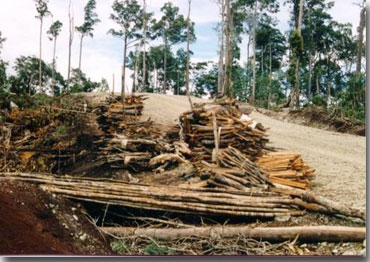 "Indigenous
peoples have the right to own, develop, control and use the lands and
territories, including the total environment of the lands, air, waters, coastal
seas, flora and fauna and other resources which they have traditionally owned
otherwise occupied or used. This includes the right to the full
recognition of their laws, traditions and customs, land-tenure systems, and
institutions for the development and management of resources, and the right to
effective measures by States to prevent any interference with, alienation of or
encroachment upon these rights. "
"Indigenous
peoples have the right to own, develop, control and use the lands and
territories, including the total environment of the lands, air, waters, coastal
seas, flora and fauna and other resources which they have traditionally owned
otherwise occupied or used. This includes the right to the full
recognition of their laws, traditions and customs, land-tenure systems, and
institutions for the development and management of resources, and the right to
effective measures by States to prevent any interference with, alienation of or
encroachment upon these rights. "
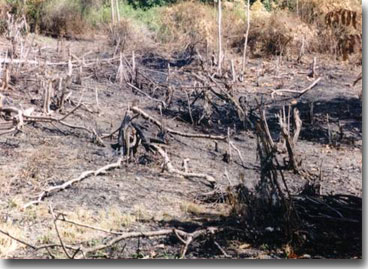 Logging
is one of the major causes of environmental destruction in Irian Jaya. As
Indonesia's own forest resources decline, it has turned its attention to Irian
Jaya. Indonesia's forest practices generally have little or no attention paid to
the environmental impact of logging. Many of the indigenous people of Irian Jaya
are threatened as vast tracts of land have been granted as concessions to timber
companies, a practice which is having severe social and physical consequences.
Logging
is one of the major causes of environmental destruction in Irian Jaya. As
Indonesia's own forest resources decline, it has turned its attention to Irian
Jaya. Indonesia's forest practices generally have little or no attention paid to
the environmental impact of logging. Many of the indigenous people of Irian Jaya
are threatened as vast tracts of land have been granted as concessions to timber
companies, a practice which is having severe social and physical consequences.
The island of New Guinea is one of the most biologically diverse in the world. There are species of flora and fauna in common with Australia, such as some marsupials, the bird of paradise and eucalyptus trees. Numerous species, unique to the island, are threatened by logging and other development projects.
Second only to the Amazon, the island of New Guinea has one of the largest tracts of tropical rainforest left in the world. Irian Jaya's forests, rich in bio-diversity, account for approximately 34.6 million hectares or 24 per cent of Indonesia's total forested area of 143 million hectares. Over 27.6 million hectares of forest in Irian Jaya have been designated as production forest.
Indonesia has encouraged the development of a large timber-processing industry by banning the export of raw logs and has become one of the world's largest exporters of plywood. As Indonesia's own forest resources decline in Sumatra and Kalimantan (there is an estimated rate of deforestation of about 1.6 million ha annually), the forestry industry has now targeted Irian Jaya. This is also part of Indonesia's "Go East" development program. Four Jakarta-based timber tycoons have divided Irian Jaya between them, this domination of the resource being achieved with support from the military government. To exploit the country's resources fully the government has given the construction of roads a high priority. These roads are being constructed in previously inaccessible areas.
The companies operating in Irian Jaya's forests include PT Djayanti Group, PT Barito Pacific Timber Group, PT Porodisa Group, PT Kayo Lapis Indonesia Group, PT Mutiara Group, PT You Lim Sari, PT Astra (Indonesia), Marubeni, Sagindo (Japan), and Mamberamo (Australia). Lavalin (Canada) has been engaged in survey work.
According to government regulations, logging in concessions is selective, but as in other tropical countries, in practice these regulations are rarely enforced. Logging roads are carelessly constructed, leading to substantial soil erosion and consequent silting of rivers and irregularity of river flow. Roads are routinely built over minor streams; the result is a roadside string of standing pools, which produce unusually high concentrations of mosquitoes and present the threat of malaria and other diseases. Logs are skidded out to the main road by heavy machinery, resulting in a dense network of bulldozer tracks. The heavy machinery destroys trees used by local people for food sources and traditional medicines.
These disruptions jeopardize the long term recovery of the forests especially if we also take into account the large amount of illegal logging and the fact there seems to be little attempt to replant previously logged areas. The Transmigration program has also been responsible for the destruction of over 900,000 ha of rainforest and this destruction will continue as more land is cleared for settlements and agriculture. The danger is that if no action is taken to stop this destruction, West Papua could lose two thirds of its forests by the year 2000.
One of the most recent conflicts is between the Moi people and the Intimpura Timber company. Like other indigenous communities in Irian Jaya, the Moi way of life is being threatened. Under Indonesian national law all land, not being actively used for agriculture, housing or industry, is state property. In 1990 the government granted a logging concession of 339,000 ha to the Intimpura Timber Company, without informing the traditional landowners. The Moi people have resisted the encroachment of the company on their land, and have made representations to the company, local government, forestry service and the army (in Indonesia, the army assists in national development and was in fact the initial owner of the logging concession). However, the government, company and the army remain firm in their policy of not recognizing any form of land rights. As the Moi have continued to protest they have been accused of being "security disturbers" (the official term for the OPM/The Free Papua Movement, and used to silence any form of indigenous protest). [back to top]
Some of the world's largest transnational mining corporations have been active in exploiting Irian Jaya's oil and minerals, including Union Oil, Amoco, Agip, Conoco, Phillips, Esso, Texaco, Mobil, Shell, Petromer Trend Exploration, Atlantic Richfield, Sun Oil and Freeport McMoran (USA); Oppenheimer (South Africa); Total (France); Ingold (Canada); Marathon Oil, Kepala Burung (UK); Dominion Mining, Aneka Tambang, BHP, Cudgen RZ, and CRA (Australia). The international dispute over West Papua during the years after 1949 can be understood in light of the natural resources in the territory, which were far better known to the transnational than revealed publicly.
An example of the level of profits involved is that of Petromer Trend and Conoco, which have produced 300 million barrels of oil from the field at Sele near Sorong, valued at $4.5 billion.
Areas where mining concessions are situated, most notably in the Ertsberg and Grasberg mountains, the Paniai and Wissel Lakes region, Fak Fak, the Baliem Valley, the "Bird's Head" western tip and the PNG border area, are where dislocation and suppression of the Papuan peoples has resulted in the most powerful uprisings and the most brutal reprisals by the Indonesian military.
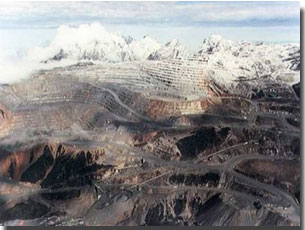 Located
in the Western Highlands is the massive Freeport Indonesia mining operation.
Freeport's Mt. Ertsberg mine is the second largest copper mine in the world, and
also contains the largest proven gold deposit in existence, valued in excess of
$US 40 billion. The latest estimate for the Mt Grasberg lode is one billion tons of ore and it is expected to have a thirty year life. The region around
the mine is closed off to outsiders, as well as to the traditional land owners
who have been dispossessed.
Located
in the Western Highlands is the massive Freeport Indonesia mining operation.
Freeport's Mt. Ertsberg mine is the second largest copper mine in the world, and
also contains the largest proven gold deposit in existence, valued in excess of
$US 40 billion. The latest estimate for the Mt Grasberg lode is one billion tons of ore and it is expected to have a thirty year life. The region around
the mine is closed off to outsiders, as well as to the traditional land owners
who have been dispossessed.
Freeport has concessions totaling 3.6 million hectares in West Papua following the recent granting of a 2.6 million hectare concession, and in March 1995 it was announced that the world's biggest mining company, RTZ of the UK, had bought an 18 per cent stake in the company, a $1.8 billion deal enabling a massive expansion of Freeport's existing operations. The Freeport company is Indonesia's largest taxpayer. Henry Kissinger, former US Secretary of State, sits on the board of directors of the parent company, Freeport McMoran, USA, based in New Orleans. (In 1993, the US Environmental Protection Agency released its 1993 pollution statistics for the entire USA. For the second year in a row, Freeport-McMoRan was the largest polluter of land, air and water, both in terms of volume and toxicity, in the whole of North America).
Freeport Indonesia's mining operation at Mt. Carstenz has led to the construction of the modern dormitory town of Tembagapura for its workforce. It has led to great disruption to the lives of the local people, the Amungme, who are prohibited from Tembagapura and are being relocated at Timika near the airport which serves the complex, and which is one of eight Transmigration settlements in the Freeport area. Freeport is building a $US500 million "new town" with an Indonesian partner near Timika on the flatlands near Grasberg, which will provide housing for up to 20,000 workers and their families. (Freeport uses Cairns as a supply base, for workers, food, machinery and as an R and R location. Freeport contributes substantially to the Cairns economy, and is actively seeking Australian investment. It already has the support of some superannuating funds in Australia).
Recently, Freeport moved the 1,000 inhabitants of the village of lower-Waa to the coastal lowlands. In one month alone, 88 people died from malaria. 14,000 people are now settled; plans are for a total of between 25,000 and 40,000 people to be resettled. In February 1995 it was announced that 2000 people living in the vicinity of the Waa, Arwaa and Tsinga valleys were to be moved in March. This is the region from which reports have filtered out of fighting in late 1994-early 1995 involving the deaths of about 40 civilians and the disappearances of up to 200 others.
Freeport mines 78,000 tons of ore/day, plus additional overburden. Virtually all of this is dumped as mine waste and tailings into the rivers surrounding Freeport, making the water toxic and thick with silt, smothering and killing all plant life along the previously fertile river banks. (Other mines like Bougainville and Ok Tedi in PNG have had similar effects). The Komoro people in the Koperapoke area have been ordered to stop consuming sago, their staple food. Freeport has distributed 78 drums to families to catch rainwater for drinking since the water has been contaminated. Plans to expand Freeport's operations within a recently granted additional 2.6 million hectare concession causes great concern for other communities and their environment.
Areas within some mining concessions have questionably been designated "earthquake zones", requiring the mass resettlement of tribes such as the Hupla of the central highlands, an unnecessary and destructive practice. Communities are often coerced into moving to lower sites, where they are more prone to diseases such as malaria and where traditional mountain foods such as pandanus trees do not grow.
The Chairman and Chief Executive of Freeport, James "Jim-Bob" Moffett in March 1995 said of his company's projects: "The potential is only limited by the imagination. Every other mining company wants to get into Irian Jaya. Bougainville and Ok Tedi don't hold a candle to Grasberg". (Ok Tedi is the gold mine in Papua New Guinea owned and operated by the Australian mining company, BHP. BHP is fighting a $4 billion law suit in the Victorian Supreme Court brought by the local land owners for environmental damage). An Indonesian group, Indonesian Forum for the Environment/WALHI, has begun court proceedings against Freeport on environmental grounds. [back to top]
Over three quarters of a million people have resettled in Irian Jaya under the government's Transmigration program. The majority are from the islands of Java and Celebes, but any Indonesian citizen and his family are able to take part in the scheme and receive assistance for transportation and establishment. As either "spontaneous", or sponsored Transmigrasi, most have been resettled in large settlements along the Indonesia/PNG border, near the large towns of Jayapura and Merauke, or in the forestry/mining areas of Sorong and Timika. The Trans-Irian Highway will soon open up to Transmigration the previously isolated rural, and more densely populated, central highlands, a region where a mining concession of over 3 million hectares has been issued by the Indonesian government.
The overall effect of the influx of immigrant unskilled and skilled labor has been to severely limit opportunities for employment of Irianese in private sector activities. Unless positive employment policies in favor of the indigenous population are pursued, continued social conflict would appear to be unavoidable.
In many regions of Irian Jaya, the indigenous people, forest dwellers such as the Moi and Asmat, are losing their traditional way of life not only to deforestation and mining projects but also to the recently revised Transmigration policy. This policy encourages forest people to resettle in camps where they will be granted a small area of land to produce their everyday necessities. In the case of the Amungme, Dani and Mbua regions, this has involved the resettlement of people to lower altitudes, away from prospective mining zones, where resistance to disease such as malaria is low. Almost a million hectares have already been cleared and allocated for settlements, with lucrative contracts awarded for clearing and construction. A Canadian company, Lavalin, has been contracted to conduct the surveying. The World Bank has been the major financer of the scheme.
Transmigration is part of the Indonesian government's stated policy of assimilating indigenous people with the goal of forging a single national identity. The Indonesian government has sought to alleviate the population pressure on Java by addressing the imbalance in population density with other so-called "outer" islands, such as West Papua, where the transmigration program is now concentrated.
It is projected that by the year 2010 the population of Irian Jaya will have grown to between 2.6 and 3.9 million. This will largely be due to transmigration, both government funded and "spontaneous", and subsequent industrialization resulting from Jakarta's "Eastward Development Policy" of 1990. Non-Irianese born already make up over 70 per cent of the province's urban population. In the current five year plan the province will receive 52,000 families of transmigrants. It is clear that a major consequence of Transmigration to Irian Jaya is the large-scale displacement of the indigenous population from their traditional lands.
Clause 17 of Indonesia's Basic Forestry Act of 1967 says:
"The rights of traditional law communities may not be allowed to stand in the way of transmigration sites",
and Article 2 of the Basic Agrarian Law of 1960 says that:
"... it is not permissible ... for a community based on its traditional rights, to refuse to allow forest land to be cleared on a large and organized scale for the implementation of large-scale projects undertaken in the framework of plans to increase the production of foodstuffs and to shift the inhabitants".
Not only do the indigenous people have no right to resist appropriation of their land for transmigrants or industry, but they are also likely to receive little or no compensation for it. For example, at Arso and other places in the vicinity of Jayapura, "the local people have received no compensation for any of the land which they have been obliged to relinquish. Furthermore, if they resist the demand for their land, they are labeled OPM, which means future military harassment and abuse".
According to the Minister of Transmigration, "the surrender of land for the needs of transmigration is not accompanied by compensation (ganti rugi) but only by granting recognition, namely a certificate of recognition of right .... Recognition can take various forms, even the form of something with no economic value such as the holding of a traditional ceremony, the presentation of agricultural implements, a church or a mosque or other social facilities."
The stated goal of transmigration is, according to the former Minister, "to integrate all the ethnic groups into one nation ... the different ethnic groups will in the long run disappear because of integration ... and there will be one kind of man ..." The official view is that the transmigration program is beneficial to the native inhabitants because it enables them to "learn from the Javanese". It has been argued that the program must be hurried along as a means of transferring agricultural knowledge while integrating the indigenous Irianese into the mainstream of the nation. On the other hand, critics of the program argue that many of the Irianese people are not ready for, nor do they desire to enter into, an imported community of agriculturalists, forced without their consent to forego their traditional land rights and culture. [back to top]
Tourism in Irian Jaya is an expanding industry but it brings with it the potential to exploit indigenous West Papuans, both culturally and economically. Virtually all tourists who come to Irian Jaya travel to the Baliem Valley in the highlands. The main town, Wamena, draws tourists who are interested in trekking and in the culture of the local Dani tribes. Unfortunately, that interest in the culture is often exploitative, and the Indonesian administration of the tourism industry is mostly concerned with economic return.
Tourists are mostly Dutch and German, with Australians conspicuously absent, probably due to the minimal press Irian Jaya attracts. Most tourist money goes to Indonesians who run the losmens, hotels and small businesses, While the local Dani people can only earn cash through petty trade at the vegetable market or by haggling with tourists over everything from the price of a photo to their occasional work as guides.
The indigenous people are treated as objects of curiosity. Although the Indonesian administration has previously tried to force them to wear clothes and live a more "civilized" lifestyle, today they are happy if they go naked because it is good for tourism. Nowadays, when villagers can afford it, the custom is to sport modern dress, cotton shorts, t-shirts and dresses. Government policy, the missionaries and now tourism have taught the locals to see traditional dress as backward, something to be ashamed of.
In the village of Manda for example, clothed villagers are barred from the village while near-naked tribes-people, well-rehearsed and divided into two twelve-member teams, cook and dance in the traditional way for camera carrying tourists. The tourists pay for the food, the dancing, the photos, some handicrafts and a night's accommodation. The next day, after the tourists have left, the villagers climb into their clothes again clothes bought using the profits of tourism.
The question all of this raises is: is this preserving or demeaning local culture?
Biak, an island off the north coast, receives luxury liners because it is one of the world's best diving spots. A five star resort opened there in 1992, the Marau Hotel, with a golf course, marine park and five luxury hotels.
Tourism can provide opportunities for indigenous people to obtain cash and develop their livelihood, while respecting their tradition. The village of Dukun for example, man- ages its own co-operative venture formed to profit from tourism, yet helps them feel pride in their culture. Here, self-determination helps to sidestep the culture shock. Tourists can stay in a village, completely built by the co-operative to house visitors, for Rp. 3,000 (A $2) a night. The villagers will dress traditionally, dance and have a feast for paying tourists. Tourism can be in keeping with the dignity of indigenous people and can help them to feel pride in their traditions.
You can visit Irian Jaya and discover for yourself the uniqueness of the country's environment and people. Helpful resources are Kal Muller's book Indonesian New Guinea, and John McCarthy's booklet, (plus discussion guide, especially designed for educational use), Are Sweet Dreams Made of This?. [back to top]
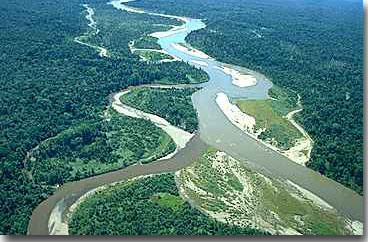 Hydro-electric
dams, as shown in other parts of the world where large-scale projects have been
undertaken, have had enormous environmental and social impacts. Plans exist for
Irian Jaya's Mamberamo River to be dammed in order to provide electricity for an
aluminums smelter. The smelter is to be operated by a Canadian company, and its
construction will in turn see the development of an industrial zone, in the
pristine northern region presently inhabited by isolated tribes.
Hydro-electric
dams, as shown in other parts of the world where large-scale projects have been
undertaken, have had enormous environmental and social impacts. Plans exist for
Irian Jaya's Mamberamo River to be dammed in order to provide electricity for an
aluminums smelter. The smelter is to be operated by a Canadian company, and its
construction will in turn see the development of an industrial zone, in the
pristine northern region presently inhabited by isolated tribes.
Professor Otto Soemarwoto, an Indonesian ecologist has said of the Asahan Dam in Sumatra:"...development has been too much emphasized for national growth. The local people have been viewed as constraints for the development projects ... resettlement schemes are in fact devices to alleviate these constraints. The projects are not conceived to benefit the local people, but people in cities and foreigners."
During and subsequent to the dam's construction, large areas of land are flooded and made uninhabitable, with a potential for the spread of water-borne diseases and malaria in the tropical environment. The people first and most directly affected will be those groups which require relocation. To be moved away from ancestral homes is especially difficult for isolated populations. The stress of relocation is indicated by a rise in morbidity rates. This applies especially to the very young and the very old. A population's resistance to illness is lowered because of the very real stress accompanying resettlement and because of sudden changes in food consumption.
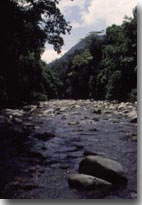 Almost
90 per cent of Mamberamo people are illiterate. Tribal groups include the Bauzi,
who live by catching fish and crocodiles in the rivers and lakes, hunting in the
forests or collecting wild fruits. The presence of the military in Mamberamo
since 1985 with a "cooperative" crocodile business, has had a great
sociological impact, especially on the local women. With tobacco, sugar and
coffee as payment for this work, the troops force the local men to catch
crocodile for weeks away from their villages, leaving the wives vulnerable to
the needs of the local troops. Existing regional health standards are already
low, and may be compounded by the influx of foreign construction and
semi-skilled workers.
Almost
90 per cent of Mamberamo people are illiterate. Tribal groups include the Bauzi,
who live by catching fish and crocodiles in the rivers and lakes, hunting in the
forests or collecting wild fruits. The presence of the military in Mamberamo
since 1985 with a "cooperative" crocodile business, has had a great
sociological impact, especially on the local women. With tobacco, sugar and
coffee as payment for this work, the troops force the local men to catch
crocodile for weeks away from their villages, leaving the wives vulnerable to
the needs of the local troops. Existing regional health standards are already
low, and may be compounded by the influx of foreign construction and
semi-skilled workers.
It would seem far more beneficial to Irian Jaya's long term development if a hydroelectric scheme very much smaller than 10,000 MW was developed in the Mamberamo area. Power generation throughout the rural areas could bring about the development of local industries and the electrification of villages. Even with the Mamberamo Dam, small scale micro-hydro schemes would be required if these needs were to be met, as Mamberamo power is intended to provide power solely to an industrial complex and new urban development. Former Minister for Research and Technology, Professor B.J. Habibie, who later became the third president replaced Soeharto, is seeking out investors for the Mamberamo Dam project, and visited Australia in May, 1995. [back to top]
